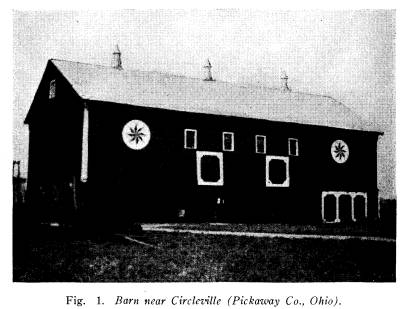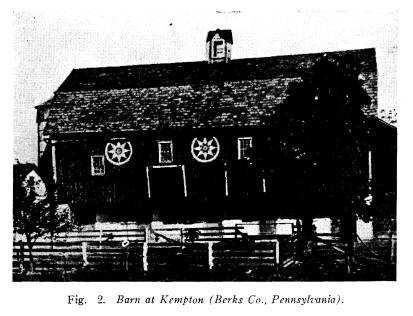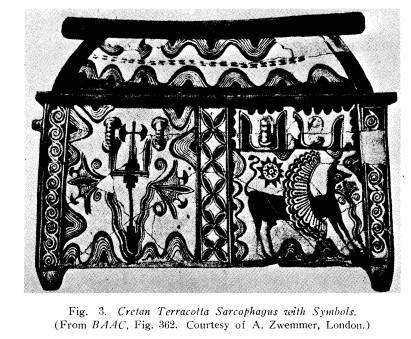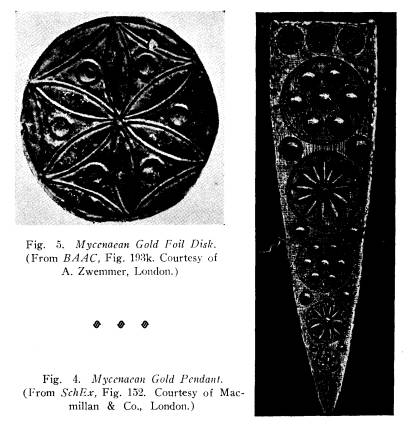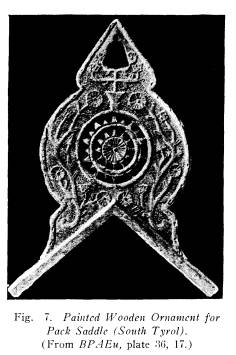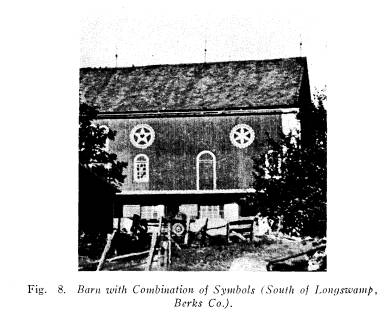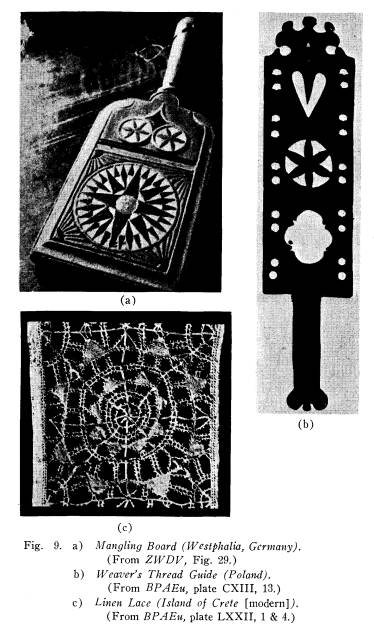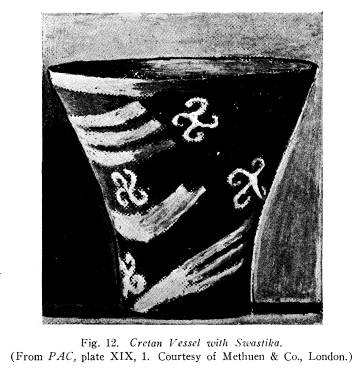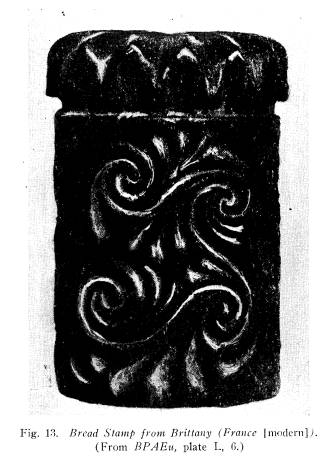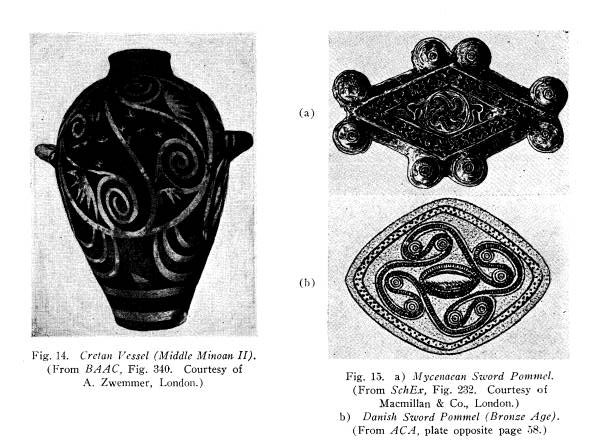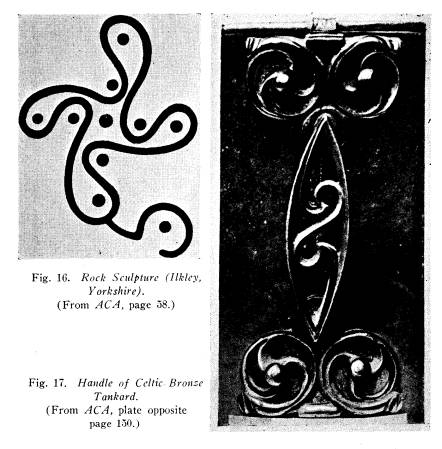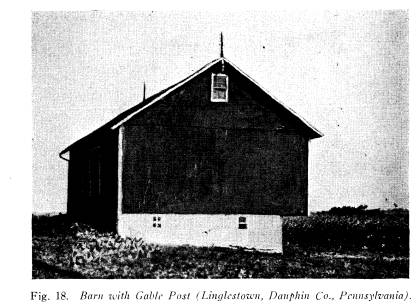Ohio History Journal
- 1
- 2
- 3
- 4
- 5
- 6
- 7
- 8
- 9
- 10
- 11
- 12
- 13
- 14
- 15
- 16
- 17
- 18
- 19
- 20
- 21
- 22
- 23
- 24
- 25
- 26
- 27
- 28
- 29
- 30
- 31
- 32
ORIGIN AND SIGNIFICANCE OF PENNSYLVANIA
DUTCH BARN SYMBOLS *
By AUGUST C. MAHR
On a great number of Pennsylvania Dutch
barns, there are
geometrical ornaments painted on the
outside walls; ornaments
which, as a rule, show some sort of star within a circular disk
(Figs. 1, 2, 8, 10b). They occur most
frequently in Berks and
the neighboring counties; less
frequently, in other parts of Penn-
sylvania; and, locally, even in Ohio and
other states of the Union
where Pennsylvania Dutch farmers have
settled.
Due to Ohio's close proximity to
Pennsylvania, as well as to
its importance, in early frontier days,
as both a temporary and
permanent place of settlement for
eastern farmers venturing west-
ward, it is in Ohio that not only barns
of Pennsylvania Dutch
structure are more frequently found than
anywhere else outside
of Pennsylvania, but here one may also
see the barn symbols that
are so striking a characteristic of the
Pennsylvania Dutch counties
mentioned above.
The Pennsylvania Dutch barn in question
is of the so-called
Swiss bank-barn type. It means that it
is erected along an em-
bankment in such a way that its main
entrance door leads to the
heavily planked floor of its wooden
upper story. This floor is at
the same time the ceiling of the lower
story formed by the stone
base structure which contains the
stables for the livestock and is
* This study grew out of a paper read
before the Anthropology Section of the
Ohio Academy of Science, at its annual
meeting, in May, 1943, at Columbus, Ohio.
The writer is glad to express his
gratitude to Professor Edgar N. Transeau of Ohio
State University for the photographs taken in
Pennsylvania, of barns shown in
these pages; to Dean Carl F. Wittke, and Professor Clarence Ward, both of Oberlin
College, for photographs and scholarly
aid; to Professors John W. Price, and Wilmer
G. Stover, both of Ohio State
University, and to Dr. James H. Rodabaugh and Mrs.
Margaret Stutsman, of the Ohio State
Archaeological and Historical Society, and Mrs.
Mary Jane Meyer, of the Ohio War History
Commission, for helpful field-work; to Dr.
Jean Weltfish, of Columbia University,
for valuable bibliographical advice; to the Grad-
uate School of Ohio State University for
generous help in securing the illustrative ma-
terial; and, last but not least, to the
publishing houses, in London, of A. Zwemmer,
Macmillan. & Co., and Methuen &
Co., Ltd., for their permission to reproduce pictures,
from works published under their
imprint, as illustrations of this article.
(I)
|
2 OHIO ARCHAEOLOGICAL AND HISTORICAL QUARTERLY |
|
|
|
accessible through doors on the lower level of the slanting terrain. As a rule, the barn, in its full length, carries a wooden fore-bay which projects from the upper story and overhangs the outside wall of the stables to the extent of about six to eight feet. Fre- quently, however, the barn is built on level ground with a ramp leading to the upper story. In Pennsylvania as well as Ohio, these barns are usually red, often with white arches over the white- framed fore-bay openings. Wherever barn symbols are found, they are painted in various colors on the fore-bay, or the back, or the gable sides, or on all four walls of the wooden superstructure. The one or other barn with such star-shaped symbols on its outer board walls is found in practically every region of Ohio where Pennsylvania Dutch from Berks County or its neighbor- hood have settled. The writer has selected at random a few lo- cations where they are in evidence today: Route 188, 1 mile east of Circleville, Pickaway Co.; farm of Mr. S. Paul Valentine (red barn with two black-and-yellow eight-pointed stars |
|
BARN SYMBOLS 3 |
|
|
|
in white disks on fore-bay). This is, without a question, one of the finest Berks County barns in Ohio. It was erected, ca. 1840, by a man of the name of Berger, from Pennsylvania. With each re-painting, the symbols, that are as old as the barn, were re-touched in black-and-yellow in order to retain the original appearance of the building (Fig. 1). Route 23, between Columbus and Delaware, a mile north of Stratford, Delaware Co. (red barn with three six-pointed stars on fore-bay). Route 203, between Delaware and Radnor, Delaware Co. (red barn with three six-pointed stars on fore-bay, and one eight-pointed star in each gable). The barn is known as "the old Sharadin barn." Route 33, between Logan and Rock Bridge, Hocking Co., 2-3 miles south of Rock Bridge (red barn with a star in each gable). Route 73, between Waynesville and Franklin, Warren Co. (barn with three sky-blue five-pointed stars on each gable side). Route 18, 2 miles north of Republic, Seneca Co.; farm of Mr. L. J. Neikirk (red barn with white curved club-armed swastika1). Route 53, 7 miles north of Upper Sandusky, Wyandot Co.; farm of Mr. R. R. Everhart (red barn with white five-pointed star in white ring). Date on barn: 1916. 1 Cf. infra, page 22. |
4
OHIO ARCHAEOLOGICAL AND HISTORICAL QUARTERLY
Despite the considerable number of
additional places where
such barn symbols occur in Ohio, it is
an undeniable fact that
they are gradually passing out of
existence, the main reason be-
ing that their magic symbolism is
rapidly dropping into oblivion
under the leveling effect of the changed
environment. Although
to a much lesser degree, the same holds
true for the Pennsylvania
Dutch countryside proper: about fifty
years ago practically no
barn in Berks County was without such
symbols; today they have
become much rarer.
By far the majority of Germans that
settled in Ohio up to
1820 did not come from Germany directly
but from Pennsylvania2
and, in particular, from Berks County.
The organized Moravian
(and other sectarian) colonies excepted,
settlers from Berks
County are frequently listed in early
Ohio local records. Trepte
mentions several German families from
that county who, in 1796,
founded and named "Miamisburg"
(Montgomery Co.).3 About
1810, the settlers of Cermantown
(Montgomery Co., Ohio), al-
most without an exception, were Germans
from Berks and Center
Counties.4 Other Pennsylvania counties in the
neighborhood of
Berks that appear in the records,
especially of Montgomery
County, Ohio, as having contributed
German settlers, are Lancas-
ter County,5 York County,6 and
Lebanon County.7
Pennsylvania Dutch immigration into Ohio
after 1820--this
being approximately the last year
covered by Trepte's excellent
study--has not yet been sufficiently
explored to furnish reliable
data. Yet, it is definitely certain that
within the next few decades
after 1820, a great number of Germans
from Pennsylvania and,
particularly, from Berks and the
neighboring counties established
themselves in various parts of Ohio.8
It is an outstanding characteristic of
the Pennsylvania Dutch
2 TDO, 174 ff. (Explanations of this and
other abbreviations will be found at
the end of this article.)
3 Ibid., 308; see also note (a): "This [Berks] was one of the
counties that gave
Ohio most of her Pennsylvania
Dutch" (Transl., A. C. M.).
4 Ibid., 312 and
313, n. (a), (c), and (g).
5 Ibid., 309 and 322.
6 Ibid., 308 and 323.
7 Ibid., 313, n. (e).
8 For instance, the writer knows, from
family records, that a group of families
which almost might be called a
"colony," about the middle of the last century, moved
from Berks and Dauphin counties,
Pennsylvania, to Delaware County, Ohio, where
they are still in evidence.
BARN SYMBOLS 5
that they have emigrated from
Pennsylvania in groups rather than
individually and that, thereby, they
have preserved a great many
of their traditions and general habits
of life in the new environ-
ment. What, therefore, in the subsequent
pages is said about the
Pennsylvania Dutch and their barn
symbols in Pennsylvania, ba-
sically applies also to those in Ohio or
other locations where they
have settled. This study, however, is
concerned with the funda-
mental facts about these symbols rather
than with their present-
day application.
The barn symbols are popularly called
"Hex Signs," that is,
protective magic against witchcraft. The
"Dutch" in Pennsylvania
and, in particular, the owners of barns
that bear such marks as-
sure the inquisitive stranger, however,
that the object of these de-
signs is exclusively decorative.
Obviously, they are sensitive about
their "Hex Signs," especially
so if that term is used, and even the
most tactful of investigators soon finds
out that he has been han-
dling a "hot potato."
A similar guardedness in this matter
prevails among some
authors of books on Pennsylvania Dutch
life and customs, es-
pecially among those of native stock who
are sensitive of the feel-
ings of their relatives and friends. It
is not often that one finds
a writer, himself of Pennsylvania Dutch
extraction, expressing
himself with the refreshing frankness of
Mr. Weygandt who
writes: "The symbols are supposed
to keep lightning from striking
the barn that has them painted on its
wooden sides, and to prevent
the animals housed in the barn from
being bewitched, or 'ferhexed'
as we say in the vernacular."9 Some
of the native authors touch
upon the subject lightly in smiling
embarrassment. Others beat
about the bush with vague phrases of
apology for what might look
like superstition unbecoming an
otherwise quite sober-minded
group of Americans. One of the authors
has even tried to remove
the stigma of superstition by proving
that, far from being "Hex
Signs," all the various barn
symbols are "the Lilies of Ephrata"
in disguise.10 The
beautifully illustrated book provides edifying
9 C. Weygandt, The Red Hills, . . .
(Philadelphia, 1929), 126; similar state-
ments, ibid., 10 f., 65 f.
10 J. J. Stoudt, Consider the Lilies How They Grow. An
Interpretation of the
Symbolism of Pennsylvania German Art (Allentown, 1937).
6
OHIO ARCHAEOLOGICAL AND HISTORICAL QUARTERLY
reading to the fancier of local
sentimental literature, but it helps
in no way to solve the question about
the origin and meaning of
the barn symbols.
What is needed here, is an unbiased and
unemotional ap-
proach. The key-point is that the
Pennsylvania Dutch farmers,
particularly in Berks County and its
neighborhood, always have
been, and in many respects still are,
not merely farmers but peas-
ants in the best European sense. Not
everyone who tills the soil
and raises livestock is a peasant.
Whereas the mere farmer's ac-
tivities are based on cold empiric facts
that may be learned in
agricultural schools, the peasant's life
is governed by fixed cus-
toms, if not ritual, peculiar to his
particular group and origin.
These customs attend all his chores in
the fields, in the cattle-barn,
in the house, and rule his domestic
relations, his dealings with his
fellows, his dress, his habits of eating
and drinking, his recrea-
tions, in short, every step of his
earthly pilgrimage from the cradle
to the grave. Most of these rules and
customs reach down into
times immemorial. They contain many
taboos that today are no
longer obvious, and they include innumerable
symbolic actions and
signs traceable to prehistoric magic as
well as to pagan mythology
and ritual.
The Pennsylvania Dutch are quite unique
in this country, in
that they have tenaciously clung to a
great many of the peasant
traditions which their ancestors had
brought with them from the
Old Country. Again and again, they
migrated in larger and smaller
groups from the same parts, mostly the
Upper Rhine, the Rhenish
Palatinate (Rheinpfalz) and
Switzerland, but also from other
West and South German states. They are
further unique in that
they maintained their communal form of
life in the New World,
both to their own benefit and that of
William Penn and his Quaker
associates. The greater number of these
so-called "Palatines"
(Pfalzer) landed, mostly in the harbor of Philadelphia, between
1710 and 1775.11
This adherence of the Pennsylvania
Dutch, for more than two
11 Cf. R. B. Strassburger, Pennsylvania German Pioneers, 3
vols. (Norristown,
1934). This is a publication of the original lists
of arrivals in the port of Phila-
delphia from 1727 to 1808.
BARN SYMBOLS 7
centuries, to the native peasant customs
of their German fore-
fathers can only be explained by the
fact that they did not lose
their original group consciousness after
they had settled in
America. Instead of being readily
absorbed by the new environ-
ment, as were the countless individual
settlers from other German,
and non-German, peasant communities of
Europe, the Pennsyl-
vania Dutch possessed in the peasant
traditions of their old home-
land a cultural force that was
sufficiently strong to shape their
new environment into a peasant community
of distinctive charac-
ter. In achieving this, they were
substantially aided by a very
happy coincidence: the amazing
similarity between their old home-
land and Pennsylvania. This similarity
not only extends to the
physiognomy of the landscape but also to
climate and soil condi-
tions. There is hardly a region in the
Keystone State, which has
not an almost exact counterpart
somewhere in southwestern Ger-
many. Such exceptionally good fortune
allowed them to continue
in their new home, with a minimum of
adjustments, where they
had left off in the Old Country.
Nothing, in the new environment,
was so essentially different as to
estrange them from their native
peasant views and practices.12
Strangely enough, this important basic
fact has been ignored
by a recent writer about "the Dutch
country."13 He has the feel-
ing that there is a derogatory connotation
implied in the term
"peasant" since to him
"peasant" and "serf" are synonymous. His
definition of "peasantry"
makes no allowance for its most distin-
guishing, cultural feature:
namely, the age-old devotion of the
peasant, steadfastly carried from
generation to generation, to fixed
customs that govern every phase of his
life. On the grounds of
this omission, Mr. Weygandt denies the
peasant character of the
rural Pennsylvania Dutch community.
Indeed, his particular no-
tion of what constitutes
"peasantry" leaves him no other choice.
One may grant some of his prerequisites
"for the develop-
12 That is exactly the reverse of what happened to the Holland Dutch immi-
grants, who eventually became the
"Boers" in South Africa. Citing S. Cloete's The
Turning Wheel, R.
Peattie (Geography in Human Destiny [New York: Stewart, 1940],
34 f.) demonstrates how the totally
different environment transformed these stolid
Dutch peasants into impassioned, adventuring
pioneers, an entirely novel type that
retained next to none of its ancestral peasant
features.
13 C. Weygandt, The Dutch Country (New
York, 1939), 109 f.
8
OHIO ARCHAEOLOGICAL
AND HISTORICAL QUARTERLY
ment of a peasantry," such as
"a long established civilization,"
"stability in social
conditions," and "a very slowly changing order
down the years." But peasantry certainly does not include
"a
rigid caste system; recognized and
unchallenged privilege; a frank
and ungrudging acknowledgment on the
part of the many that a
chosen few are set above the
crowd." It does not agree with the
facts of history that "there must
be all these conditions or a peas-
antry cannot be."
The free peasants of Switzerland, for
example, have main-
tained for more than six hundred years
their model democratic
republic, with its rural citizenry
adhering, as staunchly as ever, to
their magnificent old peasant culture.
For another example, there
is the free peasantry of Dithmarschen
who, in 1500, victoriously
defended, in the battle of Hemmingstedt,
their liberty against the
combined nobles of Denmark and Holstein.
True, there are re-
gions where the peasants used to live in
a condition of thraldom;
but there are surely as many where, for
ages, they have been liv-
ing as their own masters on their own
soil. These well-known
facts certainly do not bear out the
statement: "Above all there
must be laborers on land of which they
do not themselves own a
foot for peasantry to be. A peasantry
presupposes an agricultural
society, in which the laborer works not
for himself, but for a land-
owner. A peasantry cannot exist in a
country in which a landlord
class does not exist, in which authority
and position and money
do not persist in a family generation
after generation."
Of course, a peasantry of Mr. Weygandt's
definition could
not exist in the United States, but that
does not alter the fact that
the Pennsylvania Dutch deserve credit
for having preserved, right
in our midst, what according to all
accepted standards is a true
German peasant culture. The majority of
those immigrants from
the Palatinate and Switzerland, who came
to Pennsylvania by the
shipload throughout most of the 18th
century, were peasants in
the best possible sense. Indeed, a great
many of them brought to
this country more than enough money for
the purchase, and sub-
sequent cultivation, of large tracts of
fertile farm lands. Had
they been, in their German homeland,
down-trodden day-laborers
BARN SYMBOLS 9
or serfs, they would never have been the
model farmers that they
are still today, nor would they have
possessed the moral dignity
and cultural vigor prerequisite to
maintaining themselves, in the
New World, as a close-knit and unique
peasant community.
The barn symbols here discussed occur in
America ex-
clusively with the Pennsylvania Dutch
peasantry. Hence one
may expect some light on their origin
and significance from anal-
ogous occurrences in German peasant art
which, like the peasant
art of any part of Europe, is a
depository of prehistoric and pagan
values otherwise long obliterated.
Of the unlimited number of different
ornamental patterns
that exist on earth, only a very few
have been designed as vessels
for symbolic concepts. Most of the
symbolic ornaments encoun-
tered in Pennsylvania Dutch peasant art
and, in particular, as
barn signs, are stars with five, six,
eight, or more, points (Figs.
1, 2, 8, 10b), but there also occurs the
one or other design that is
not a star, as, for instance, the
Swastika (Fig. 10a).
As one examines the general distribution
of these symbolic
patterns one easily sees that their use
by the Pennsylvania Dutch
is just one instance among many others.
Up to the present day,
and regardless of period styles and
local tendencies in the dec-
orative arts, they occur in the peasant
art and craft, not of Ger-
many alone, but of all European
countries without an exception.
Naturally, the question arises: where
and why have they orig-
inated? And next: why and how have they
spread the way they
did?
There is ample evidence14 that
these various symbols that oc-
cur in European peasant art, inclusive
of the Pennsylvania Dutch
area, have their origin in a Cult of the
Sun that during the Bronze
Age was practiced "in Ireland on
the west and throughout the
greater part of Europe."15
It is more than probable that the cultic
initiative came from
the Mediterranean, and that the symbols,
along with the Sun Cult,
were carried over well-established trade
routes all throughout
Europe. Some of these routes, the
earliest in fact, were the sea
14 Cf. infra, page 15 ff.
15 COPA, 254 ff.
10
OHIO ARCHAEOLOGICAL AND HISTORICAL QUARTERLY
lanes by which the Cretans and
Mycenaeans transported their fin-
ished products, mainly bronze objects
and pottery, not only along
the entire Mediterranean coast but also
"to Great Britain for cop-
per and tin; to Ireland for gold; they
also visited the coasts of
the English Channel, and the North Sea;
and traded for amber
with the inhabitants of Denmark."16
By far the greater exchange of goods
took place, however,
over cross-continental trade routes. Two
of them led to the amber
deposits of the North: one ran from the
Adriatic over the Bren-
ner Pass, down the river Inn to the
Danube, and from there,
across the Bohemian Forest, down the
valley of the Moldau and
along the river Elbe to its mouth. Another
started at the Gulf of
Trieste, ran northeast to Laibach and
Graz and descended to the
Danube. "The tributary March was
then ascended and, after
crossing Moravia, the route passed
through Silesia and followed
the Oder to the [Baltic] coast." A
branch route "diverged from
this one at Posen and followed the
Vistula to Danzig."
"A third less important route led
to the North Sea from the
Mediterranean, by way of the Rhone and
the Rhine."
"Besides these main 'Amber Routes'
there were routes across
Alpine passes to France and Germany
which followed the Rhone,
Loire, Seine and Rhine, and routes to
and along the broad Danube
Valley by way of the Inn, Save, and
other tributaries."17
Considering the indubitable existence of
the Sun Cult among
the people who utilized these trade
routes both by land and sea
for over a thousand years previous to
the dawn of history, one is
not surprised to find the symbolic
emblems of that Cult spread,
even today, among the folk of the entire
area that was once trav-
ersed by these trade channels. The most
significant of all was the
Danube Valley route, not only because of
its importance as a di-
rect connection between Southeastern and
West Central Europe
but also because it was traversed on a
great number of points by
the "Amber Routes." The most
careful and methodical explora-
tion of Bronze Age sites, throughout the
entire European conti-
16 Ibid., 261 f.
17 The above survey of the Bronze Age trade routes of Europe has been
condensed,
and partly quoted, from COPA, 256
ff. where also a good map is found (page 258).
BARN SYMBOLS 11
nent, over many decades, has proved that
"the Sun Cult must have
been in honor throughout Europe for at
least 1500 years, and was
consequently one of the most enduring
religions the world has
known."18
Beyond being graphic representations of
the powers ven-
erated, the symbolic signs in
practically every known religion that
possesses such, are widely used for
magic purposes. The people
carry them on their bodies as protective
amulets, they apply them
to their houses, stables, and barns,
furniture and household uten-
sils, either to ward off evil influences
or to enlist the aid of ben-
eficent powers in securing fertility and
good health for themselves,
their livestock and their crops. This
being true today, in Christian
countries, it must have been even more
so in prehistoric times
when religion and magic were one and the
same.
It has been argued that designs of this
nature may have orig-
inated independently in various parts of
the earth. That may be
true for a very few and very primitive
ornamental patterns, such
as straight and curved lines, both
single and parallel; zigzag and
wavy bands; cross-hatch; triangles,
quadrangles and circles. It
cannot apply, however, wherever a symbolic significance attaches
to the ornament. Once a design has
acquired the quality of sym-
bol, this quality inevitably functions
as the vehicle by which the
design as such is carried from place to
place. This elemental in-
terrelation remains constant, regardless
of modifications that both
the symbolic meaning and the design
itself may have undergone
during their wanderings throughout the
ages. It also explains
why today these designs are
promiscuously and interchangeably
applied as propitious symbols, while
their original function, magic
or ritual, has long been obliterated or,
at best, can be but vaguely
discerned through the veil of time.
No matter what amount of migration and
political re-group-
ing has taken place on the continent,
during the Early European
Iron (Hallstadt) Age and the subsequent
eras of history, the
ancient symbols have continued in use
among the European peas-
antry, up to this day. This proves
indirectly that all participants
18 COPA, 255.
|
12 OHIO ARCHAOLOGICAL AND HISTORICAL QUARTERLY |
|
|
|
in such migrations and political re-shufflings, invaders and invaded alike, possessed the identical sub-stratum of magic concepts and were unaffected by subsequent religious creeds of a higher spiri- tuality successively superimposed upon them. It is still in this magic sub-stratum, unchanged throughout the ages and apparently unchangeable, that even today all popular credences are rooted. For the validity of this statement it matters not what magic is used, but that magic is used. The first dating of the application of such symbolic designs in the European Bronze Age becomes possible through their oc- currence in the Aegean Culture of the Eastern Mediterranean.19 They are found on the Island of Crete, and at Mycenae, and some even in pre-Aegean cultures of Western Asia. Figure 3 shows a star-shaped symbol on a Cretan terracotta sarcophagus (of ca. 19 For the dating of the Bronze Age, cf. 0. Montelius, "Bronzezeit," in Reallexikon der Vorgeschichte, ed. M. Ebert, Vol. II, 925; quoted COPA, 208. |
|
BARN SYMBOLS 13 |
|
|
|
1300 B. C.); Figure 4 represents a gold pendant with many- pointed stars, probably used as an amulet. It was found, by Schliemann, at Mycenae, and it is to be dated at ca. 1550 B. C. Of the same provenience, date and magic function, is the gold-foil ornament shown in Figure 5, whose design is the "six-petaled flower-star"20 so familiar to all students of folk art. Evidently all three of these star-like designs are symbols of the sun. It appears that all of them, especially the latter, sec- ondarily and much later, acquired some bearing on fertility, for 20 The writer has adopted this term for the sake of convenient description al- though the design surely was never meant to represent a flower. |
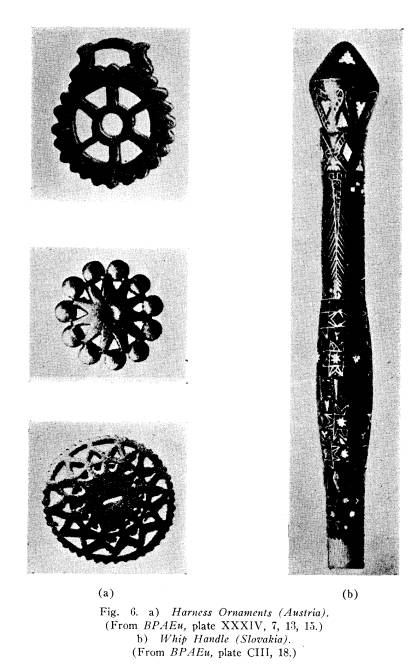
|
BARN SYMBOLS 15 they are almost universally found, alone or in combinations, on peasant utensils pertaining to the care of livestock, in particular, of horses (Figs. 6 and 7).21 |
|
The connection of the sun symbol with the horse is primary, that with other livestock, secondary and by anal- ogy, as it were. Danish and Irish Bronze Age findings prove that the horse itself figured as a symbol in this early Sun Cult. In Denmark there was discovered "an en- graved bronze disk six inches in diameter, cov- ered with gold foil, mounted on a wheeled carriage drawn by a horse." Similar disks found in Ireland show a design almost identical with that on the Danish disk. "The date of this sun chariot is about 1300 |
|
|
|
B. C. The Irish disks have lugs on the margin exactly as in the Danish specimen, the lower one for fastening it to the axle and the upper one for holding the reins."22 The discovery of two more horses, fragments of a ceremonial carriage, and of another sun disk prove beyond a doubt the age-old connection of the horse with sun worship, later fixed in the familiar Graeco-Italic myth of the sun god traveling across the sky in a chariot drawn by horses. Although in northern and central Europe no such later 21 Further illustrations: from Sweden, in HPASw, Figs. 189, 192, 196; from Tyrol, in HPAAu, Figs. 138-40; from Northern Italy, in HPAIt, Figs. 341-3, 366-8, 373-4. 22 COPA, 254. |
|
16 OHIO ARCHAEOLOGICAL AND HISTORICAL QUARTERLY formulation seems to have originated (or, if originated, was superseded by other religious notions), yet the persistent oc- currence, in European peasant art, of sun symbols in connection with horses shows the enormous surviving power of the primeval concept. |
|
|
|
As stated above, it appears that the initiative toward this widespread Sun Cult came from the Aegeans, and that the Cult itself, together with its symbols, traveled along the various cross- continental trade routes, from the coastal trading posts of the Aegeans, to practically all parts of Europe. Indirect evidence for this comes from the fact that symbolic objects pertaining to other Aegean cults were likewise found at various inland points of Europe while the cults themselves have left no traces. Several copper specimens of the typically Cretan symbolic Double-Ax, found in France and Germany, "with a perforation too small to |
|
BARN SYMBOLS 17 |
|
|
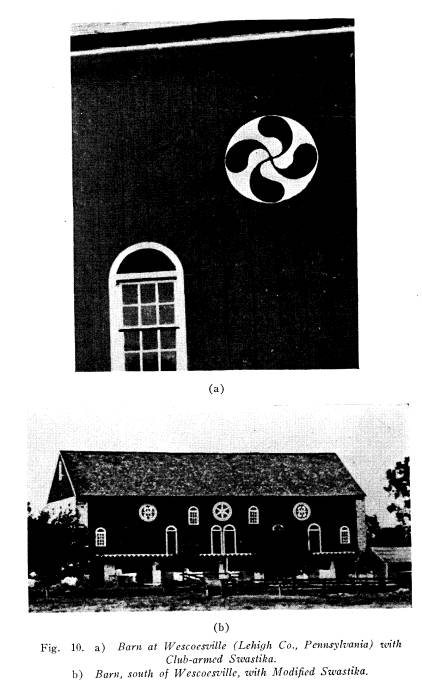
BARN SYMBOLS 19
take an actual shaft, seem to mark an
early trade route," for "it
is likely, too, that this sacred symbol
was invested with an ex-
change value."23
Moreover, from the Copper Age until far
into the Early Iron
(Hallstadt) Age, there occur, especially
in Ireland, but also else-
where, crescent-shaped personal
ornaments very similar to those
luniform necklaces of embossed gold foil
found in Mycenaean
tombs.
It matters little whether they are to be interpreted as
moon symbols or as horns of the Sacred
Bull whose worship was
linked, on the Island of Crete, with
that of the Double-Ax.
Doubtless they were cultic symbols, and
their occurrence in cen-
tral and western Europe is surely due to
Aegean influences having
filtered in from the coastal trading
posts. A probable reason for
the universal acceptance of the Sun Cult
may have been its singular
appeal to the inhabitants of the
northern moderate zone. Its sym-
bolic "astral representations,
especially the solar disk or forms
derived from it"24 have been continually used for magical pur-
poses from the earliest times to the
present day.
The frequent combination of the
"six-petaled flower-star"
with some other solar symbol on European
peasant utensils per-
taining to horses and cattle25 is
also found on a number of Penn-
sylvania Dutch barns, as is shown in
Figures 8 and 10b.
Similar combinations also occur, all
over Europe, on various
kinds of objects used by the peasantry
in the processing of flax
and wool, in the spinning and weaving of
linen, in the making and
laundering of linen goods, particularly
on distaffs, weaver's tools,
mangling boards, laundry beetles, etc.,
and they are even found in
the patterns of lace (Figs. 9a, b, c).26
Evidence for the prehistoric connection
of magic sun symbols
with spinning is found in the occurrence
of the swastika, both
angular and curved, on a great many
spinning whorls unearthed
by Schliemann on the site of ancient
Troy (3rd and 4th city).27
23 CDoEC, 34, 258, 313 (Map IV); see also supra, Fig. 3,
left half.
24 COPA, 298.
25 Supra, page 13
ff.
26 Further illustrations: from Sweden, Lapland, and Iceland, in
HPASw, Figs.
143-7, 149, 152, 155, 158, 159, 173-5,
177, 179, 180; from Russia, in HPARus, Figs.
188-202; from Lithuania, in HPARus,
Figs. 527-31; from Italy (Abruzzi), in HPAIt,
Fig. 362a.
27 Numerous illustrations in
Schliemann's Ilios, some of which are reproduced
in WSw, Figs. 64, 69, 78, 101.
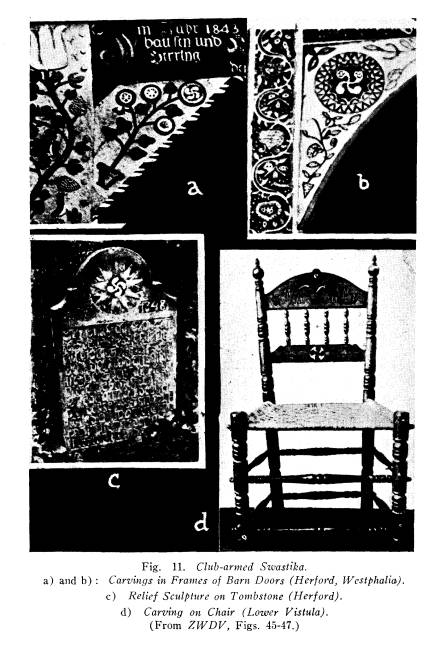
BARN SYMBOLS 21
Besides, the above-mentioned combination
of symbols is fre-
quently used on cradles, beds, salt
containers, spoons, spoon racks,
and other implements of the peasant
household.28
The heart-shaped figures, occasionally
combined with any of
these symbols, may belong to a later
stratum of symbolism, al-
though certain heart-shaped ornaments do
occur on ancient Cretan
pottery.
The "six-petaled flower-star,"
evidently as a pre-Christian
sign of immortality, appears as the
predominant symbol on grave-
posts in Bosnia.29
In some parts of the Old Saxon region (Nicdersachsen,
Ger-
many), stars, in combination with other
symbols, are frequently
painted on, or carved into, the frames
of barn doors (supra, Fig.
11a, and ZWDV, Fig. 22).
Also with the Pennsylvania Dutch, these
symbols, apart from
their use as barn signs, are applied to
all kinds of utensils of the
rural household.
Another symbol used by the Pennsylvania
Dutch, both on
barns and otherwise, is the swastika;
not, however, the familiar,
angular, form but the swastika with
curved club-shaped arms such
as found on a barn at Wescoesville
(Lehigh County) (Fig. 10a).
Another barn, about one mile south of
Wescoesville, on the road
to Macungie, shows a variant: instead of
all four arms bending
in the same direction, here both the
upper and the lower pair of
arms are curved towards each other (Fig.
10b). Although this
modification of the symbol is likewise
of great antiquity (cf. su-
pra, note 27), it may be regarded, in the present case, as
merely
a local variant. That is all the more
likely since other variations
which are purposely fanciful also occur
as barn symbols in south-
eastern Pennsylvania.
The pure form of the curved club-armed
swastika is likewise
found in other parts of the Pennsylvania
Dutch area, both as a
barn symbol30 and applied to
other objects. An elaborate piece of
needle-work "made in 1826 by an
emigrant from the Palatinate"31
28 For illustrations see the standard
works on peasant art, as previously cited.
29 HPAAu, Fig. 506.
30 American Architect, Vol. CLI (1937), page 74.
31 American-German Review, Vol. VII (1941), No. 5 (June), page 2.
|
22 OHIO ARCHAEOLOGICAL AND HISTORICAL QUARTERLY shows two of them below a third (which is a variant of the pure form). As a barn symbol it also occurs in Ohio where it can be seen painted on the barn of Mr. L. J. Neikirk, Route 18, two miles north of Republic, in Seneca County (cf. supra, page 3). |
|
|
|
In Germany it is not at all frequent, except in a clearly de- fined area in Westphalia: the District of Herford; secondarily, it occurs in the flat-lands at the mouth of the Vistula (Weichsel- niederung), near Danzig, a region colonized, centuries ago, by set- tlers from the Old Saxon country, presumably Westphalians from the Herford area. This swastika with curved club-shaped arms is merely a va- |
BARN SYMBOLS 23
riant of the more familiar, angular,
design. As a symbol, most
probably also of the sun, the swastika
presumably originated in
India, in prehistoric Dravidian times.
From there it traveled both
west and east, possibly even, by way of
northeastern Asia, into
the western hemisphere.32 Wherever
it occurs later on, be it the
East or the West, it conveys some
propitious meaning of good
luck, happiness, long life, or magic
protection against evil influ-
ences. In a few cases, it was
secondarily adopted into later re-
ligions and local cults.
An attempt to trace the swastika, and in
particular its curved
variant, into western Europe again leads
to the Aegean culture of
the Island of Crete. On a clay vessel
(Middle Minoan I, ca. 2100
B. C.) there occurs the curved swastika,
probably an importation
from an earlier, Anatolian, culture
(Fig. 12).
It evidently spread, together with the
other symbols of the
Sun Cult, from the sea inland by way of
the continental trade
routes of the Bronze Age, for it occurs,
for instance, on a modern
wooden stamp, from Brittany (France),
used for the marking of
consecrated bread (Fig. 13). The design,
far from being Chris-
tian, is a swastika-like symbol found,
in basically the same form,
on a Cretan vessel (Middle Minoan II, ca.
1800 B. C.) (Fig. 14).
A striking similarity, that can hardly
be called accidental, pre-
vails between two swastika designs, both
on sword pommels, the
one from Mycenae (Fig. 15a), the other
from a Bronze Age de-
posit in Denmark (Fig. 15b).33
The very same tendency in design appears
in a symbolic rock
sculpture of the British Bronze Age,
near Ilkley, in Yorkshire
(Fig. 16). Its "winding band"
character reveals its connection
with the ornamental style demonstrated
in Figures 15a and 15b.34
There are strong indications that the
people who made this
rock sculpture were Celts of the
Goidelic dialect type. Moreover,
it was in Celtic-speaking Brittany that
the bread stamp with that
32 About the
history of the swastika, see especially WSw, passim.
33 It may prove of some archaeological importance that a design of very
much
the same
character has been found on a piece of Moundbuilder potteryware, at
Glendora Plantation, Louisiana ("Lower Mississippi
Area"); cf. H. C. Shetrone, The
Mound-Builders (New York & London: Appleton, 1941), Fig. 82 (page
142), 145 f.,
371 ff.
34 Cf. ACA, 57 ff.
|
24 OHIO ARCHAEOLOGICAL AND HISTORICAL QUARTERLY swastika-like symbol was found which has been discussed above (page 23). Further, the region about Herford, in Westphalia, where the curved club-armed swastika prevails, represents, in its |
|
|
|
peasant houses, a much older, almost purely Celtic, type than those of the surrounding Saxons.35 There is other evidence that this region about Herford is to be regarded as an enclave with a Celtic 35 MSAW, 315 ff. |
26 OHIO ARCHEOLOGICAL AND HISTORICAL QUARTERLY
past in the otherwise Saxon area.36
This permits the inference
that the curved club-armed swastika
symbol was especially culti-
vated by Celtic people. Such an
assumption is strengthened by
the fact that Celtic ornamentation, as a
whole, from the late
Bronze Age onward, for centuries favored
the swastika and re-
lated patterns, and, in their
delineation, showed a tendency toward
curved, bulging, designs with
club-shaped terminations (Fig 17).37
The universal occurrence of these
age-old designs as propi-
tious or magic symbols among the
European and, in particular, the
German peasantry naturally makes it
impossible to determine by
which of the various German groups that
constitute the Pennsyl-
vania Dutch any given symbol was
introduced. The very fact that,
even in the German homeland, they all
had been familiar with all
those symbols and their miraculous
powers, renders the whole
question immaterial.
In this connection the writer wishes to
mention Mr. Wey-
gandt's statement that "some of the
shapes of these [barn] sym-
bols undoubtedly have their origin in
Rosicrucian symbols, which
were a matter of moment to several
groups among the German
Pietists, etc., etc."38 It
is unfortunate that Mr. Weygandt is not
more explicit about the symbols he had
in mind, as he wrote these
lines. Among the symbolic signs of the
Rosicrucians, such as pre-
sented by Jennings,39 the
writer has found only three symbols that
are used as Pennsylvania Dutch barn
signs: the familiar penta-
gram
(Trudenfuss);40 a six-pointed star;41 and an eight-pointed
star,42 the two latter,
moreover, expressly and unmistakably desig-
nated as sun symbols. Should Mr.
Weygandt have referred to
these star symbols as being of
Rosicrucian origin, then he would
have to explain how the identical
symbols also occur on Pennsyl-
vania Dutch household articles in
exactly the same application as
on analogous peasant utensils all over
Germany and the rest of
Europe. It is obvious that the
Rosicrucians came by these symbols
36 HDL, 30 ff.
37 Cf. ACA, 150 f., where this
style of design is appropriately termed "flam-
boyant."
38 C. Weygandt, The Red Hills,
. . . (Philadelphia, 1929), 126.
39 H. Jennings, The Rosicrucians, .
. . (London, n. d.), 6th edition.
40 Ibid., 299 (Fig.
235).
41 Ibid., plate I, bottom.
42 Ibid., plate I, top.
|
BARN SYMBOLS 27 |
|
|
|
the same way as did the Pennsylvania Dutch: by way of age-old heritage. In none of the German lands from which the mixed popula- tion of Pennsylvania's barn sign area had recruited itself, does one find such symbols painted on the front of barns as in Berks and the adjacent counties. In fact, with the exception of certain districts in Lower Saxony where they occur on the frames of barn doors,43 one finds them painted on houses only in Switzer- 43 Supra, Fig. 11. |
28
OHIO ARCHAEOLOGICAL AND HISTORICAL QUARTERLY
land, mainly in the Canton of Bern.
While the contribution of the
North German plains of Lower Saxony to
the population of the
Pennsylvania Dutch country-side is
negligible, Swiss peasants from
the Canton of Bern have not only settled
in great numbers in
Berks County and the neighboring region,
but they have also made
their Alemannian type of barn the
generally accepted form in
these counties and beyond. In their
applying the star symbols to all
kinds of household utensils they do not
differ from the Palatines
and other settlers from Upper Germany
that moved into Penn-
sylvania. But they do differ in
their tendency of applying stars and
related ornamented disk patterns to
human habitations, frontally
and otherwise, although not to barns.44
The fact that the homes in the New
Country were not built
of wood, as they had been in the Swiss
homeland, while the barns
continued to be wooden structures, may
have been the reason why
the symbols were applied, not to the
residence with its limited wall
space of stone masonry, but to the front
of the barn, for this pro-
vided the familiar expanse of board wall
for symbolic ornamenta-
tion.
Once the tendency to paint symbols on
the barns had been
introduced by the Swiss, the other
German immigrant groups
readily adopted it as they had similarly
adopted the Swiss type of
barn. The only districts in the
Pennsylvania Dutch area where
barn symbols have never been applied are
the communities of the
Mennonites (in particular, the Amish)
who have always regarded
their use as sinful.
Swiss initiative has left its traces in
still another item of
Pennsylvania Dutch farm architecture: the carved gable posts
found on barns in Dauphin County,
especially near Linglestown
(Fig. 18). In mentioning this, the
writer is not even digressing
since these posts, basically, share with
the barn symbols an ancient
cultic significance and protective magic
function. Their probable
provenience from the worship of Donar
(Thor), the highest god
44 Cf. E. Gladbach, Charakteristische Holzbauten der Schweiz (Berlin
& New York:
Hessling, 1906), plate IX, 3: Door with
Stars; plate XXVI, 1 and 5: Chairs with
Stars; plate XXIX: Ornamented Disks
(1828 A. D.). See also The Brochure Series
of Architectural Illustration (Boston: Bates & Guild), VII (1901), 79:
Six-pointed
Star on eave console of residence, in a
street at Adelboden, Canton of Bern.
|
BARN SYMBOLS 29 |
|
|
|
of the Germans south of the Wodan-worshipping plains region of Old Saxony, makes it appear that their presumable functions were the protection of the barn against lightning, and the securing of fertility for the cattle kept therein. It is certain that they were introduced into Dauphin County from the Alemannian region, the very heart of the ancient Donar Cult, as is evident from the names of early settlers listed in assessment and taxation records of Pax- tang Township, 1777 and 1780. They are almost all German- Swiss.45 The author cannot consider this study in the origin and sig- nificance of the barn symbols completed without also touching upon their subjective significance. In other words, it is not suffi- cient for a comprehensive treatment of this topic to have discussed their objective significance on the basis of historical and archaeo- logical evidence. The much more important side of their signifi- 45 W. E. Egle, History of the Counties of Dauphin and Lebanon, . . . (Philadel- phia, 1883), 101 and 289. |
30
OHIO ARCHAEOLOGICAL AND HISTORICAL QUARTERLY
cance is covered by the question: what
do they mean to the people
who apply them even today in the
Pennsylvania Dutch country?
The unquestionable credence these magic
symbols have been
receiving, both in Europe and
Pennsylvania,46 can only be ex-
plained on the basis of peasant
psychology, which is group psychol-
ogy. The individual peasant may
be entirely honest in telling the
stranger that he does not believe in
"such things." Just the same,
as a member of his peasant community he
cannot extricate himself
from the group belief which is
super-individual. He applies sym-
bols to his barn or household utensils,
not because he, as a person,
feels that he must have them, but
because "one has to have them."
The group spirit commands it so.
With outsiders he does not even touch
upon such matters; it
is taboo. A feeling akin to chastity
keeps his lips sealed in the
presence of the "gentile" from
"abroad," who "does not speak his
language." This is not merely a
figure of speech but is to be taken
literally. That was brought home to the
writer by an unforgettable
experience:
A few years ago, I spent a few days in
Berks County as a guest in
the home of an old lady, now dead. She
was of old Pennsylvania Dutch
stock and loved to tell stories about
the days of the past and about the
people she had known. I would not tire
listening to her, nor would she,
answering my questions.
In the beginning of my stay, she spoke
to me in English, as she would
to all visitors not of the native kin.
Some fine day, however, she discovered
that I did not only understand her
Pennsylvania Dutch, but that I even
could talk "her own language."
This I accomplished by simply speaking
my Rhine-Hessian home dialect with a few
concessions to Berks County
vocabulary and phonology. No matter how
well or how badly I did it, I
distinctly felt that I now was
"accepted": I spoke her language, I was no
longer an "outsider." Every
word, every gesture from her intimated that
she trusted me with
"understanding."
A day or two later, as usual, I was
helping her in the kitchen with
the washing of the breakfast dishes.
Although she appreciated the little
service, it always embarrassed her a bit
that a man, moreover a guest,
should be doing house-work as long as
she, a woman, was around to do it.
The point was that her "group"
does not approve of men doing kitchen
chores. This embarrassment always drove
her into her shell, as it were,
and made her speak English.
46 For literary evidence, cf. Mr.
Weygandt's statements, supra, page 5.
BARN SYMBOLS 31
That particular morning, our talk
somehow drifted toward the deli-
cate topic of Hexerei (witchcraft)
and protection against it by means of
barn symbols and other magic. Quite
casually, I asked her whether the
people in the neighborhood really
believed in it. She said that she did not
think so although she was not quite
sure. Maybe, there were still a few
that did. Never was I to think that she
and her family had ever believed
in things of that sort.
All this had been said in English, mind
you. It was obvious that she
had conveyed to me what the
"group" expected her to answer the "outsider"
who asked such questions. Thereafter,
she was silent, so pointedly silent
that no request to drop the subject
could have been more eloquent.
Then came the psychological climax.
After a pensive pause, her face
quite unexpectedly brightened, and she
broke into story-telling. This time
in Pennsylvania Dutch. She told me stories about her father, her mother,
her sisters, and other members of her Freundschaft
(kith and kin): what
each of them had done, on this and that
occasion, to ward off evil influences
that threatened them from certain people
reputed to practice witchcraft.
Some such person had come to the house,
under a flimsy pretext, or had
been observed loitering near the
cattle-barn. Then, of course, the preventive
measures had to be taken which
"everybody" takes in such a case. Although
there were Hex Signs on the barn,
certain objects were shoved under the
door-sill of the cow-stable; certain
chalk-marks were written on door posts;
certain herbs were hung near the
cattle-stands. Otherwise the cows might
have dried up, or given bloody milk.
All this and more she told me, revelling
in memories. How was that
to be explained? Was she aware of
contradicting herself? No, she was not.
What had happened, was this: All the
time that we had been speaking
English, under the cloud of her
embarrassment, I had been to her the
"outsider" who "did not
speak her language," that is, the language of the
"group." Furthermore, in conformity with her
"group" ethics, she had
told the "outsider" what,
under the circumstances, "one says" to the "out-
sider" in the outsider's language.
He need not, in fact he must not, know
what the "group" knows and
believes.
Of a sudden, however, it must have
occurred to her that, after all, I
did "speak her language" and, therefore, really
was an "insider." So she
dropped into Pennsylvania Dutch, and as
she was "speaking her language,"
she was speaking "within the
group," where alone it is spoken and under-
stood, and where secretiveness is not in
order. She felt that there was no
harm done by my being "in the
know," and so she told me all she
remembered.
Time will show how long the Pennsylania
Dutch will be able
to maintain themselves as a group.
Advancing radially from
the big cities, the standardizing and
mechanizing forces of today's
32 OHIO ARCHAEOLOGICAL AND HISTORICAL
QUARTERLY
steel-and-concrete
civilization are steam-rolling over the peasant
minority of the country-side. At the rate of this deadly on-
slaught,
group-consciousness is being wiped out and, along with
it, the barn symbols,
the beliefs for which they stand, and all
other values of this
old peasant culture.
BIBLIOGRAPHY AND
ABBREVIATIONS
Bock titles cited in
the foot-notes are here not repeated.
ACA Allen, J.R., Celtic Art
in Pagan and Christian Times
(Philadelphia:
Jacobs, n.d.).
BAAC Bossert,
H.Th., The Art of Ancient Crete (London:
Zwemmer, 1937).
BPAEu ................, Peasant Art in Europe (Berlin: Wasmuth,
1926).
CDoEC Childe,
V.G., The Dawn of European
Civilization
(London [New York],
1927).
COPA Cleland,
H.F., Our Prehistoric Ancestors (New
York:
Coward-McCann, Inc.,
1928).
HDL Hofmann, A. v., Das deutsche
Land und die deutsche
Geschichte (Berlin & Leipzig: Deutsche
Verlagsanstalt,
1923).
HPAAu Holme,
Chas., Peasant Art of Austria and
Hungary
(London: The Studio,
1911).
HPAIt ................, Peasant Art of Italy (London: The Studio,
1913).
HPARus ..............., Peasant Art of Russia (London: The Studio,
1912).
HPASw ............., Peasant Art of Sweden, Lapland and Iceland
(London: The Studio,
1910).
MSAW Meitzen,
A., Siedlung and Agrarwesen der
Westgermanen,
... (Berlin: Hertz,
1895).
PAC Pendlebury, J.D., The
Archaeology of Crete (London:
Methuen, 1939).
SchEx Schuchhardt,
C., Schliemann's Excavations (London:
Macmillan, 1891).
TDO Trepte,
H., Deutschtum in Ohio (Doctoral
Dissertation,
Leipzig, 1931) [in Deutsch-Amerikanische
Geschichtsblatter
(German-American Re-
view), (Chicago), XXXII (1932), 155-409).
WSw Wilson,
Thos., "The Swastika, ..
." [in Reports, Smith-
sonian
Institution; U. S. National Museum,
1893-1894 (Washington, 1896), pp. 757-
1011].
ZWDV Zaborsky- Urvatererbe
in deutscher Volkskunst (Leip-
Wahlstatten, O.v., zig: Koehler & Amelang,
1936).
ORIGIN AND SIGNIFICANCE OF PENNSYLVANIA
DUTCH BARN SYMBOLS *
By AUGUST C. MAHR
On a great number of Pennsylvania Dutch
barns, there are
geometrical ornaments painted on the
outside walls; ornaments
which, as a rule, show some sort of star within a circular disk
(Figs. 1, 2, 8, 10b). They occur most
frequently in Berks and
the neighboring counties; less
frequently, in other parts of Penn-
sylvania; and, locally, even in Ohio and
other states of the Union
where Pennsylvania Dutch farmers have
settled.
Due to Ohio's close proximity to
Pennsylvania, as well as to
its importance, in early frontier days,
as both a temporary and
permanent place of settlement for
eastern farmers venturing west-
ward, it is in Ohio that not only barns
of Pennsylvania Dutch
structure are more frequently found than
anywhere else outside
of Pennsylvania, but here one may also
see the barn symbols that
are so striking a characteristic of the
Pennsylvania Dutch counties
mentioned above.
The Pennsylvania Dutch barn in question
is of the so-called
Swiss bank-barn type. It means that it
is erected along an em-
bankment in such a way that its main
entrance door leads to the
heavily planked floor of its wooden
upper story. This floor is at
the same time the ceiling of the lower
story formed by the stone
base structure which contains the
stables for the livestock and is
* This study grew out of a paper read
before the Anthropology Section of the
Ohio Academy of Science, at its annual
meeting, in May, 1943, at Columbus, Ohio.
The writer is glad to express his
gratitude to Professor Edgar N. Transeau of Ohio
State University for the photographs taken in
Pennsylvania, of barns shown in
these pages; to Dean Carl F. Wittke, and Professor Clarence Ward, both of Oberlin
College, for photographs and scholarly
aid; to Professors John W. Price, and Wilmer
G. Stover, both of Ohio State
University, and to Dr. James H. Rodabaugh and Mrs.
Margaret Stutsman, of the Ohio State
Archaeological and Historical Society, and Mrs.
Mary Jane Meyer, of the Ohio War History
Commission, for helpful field-work; to Dr.
Jean Weltfish, of Columbia University,
for valuable bibliographical advice; to the Grad-
uate School of Ohio State University for
generous help in securing the illustrative ma-
terial; and, last but not least, to the
publishing houses, in London, of A. Zwemmer,
Macmillan. & Co., and Methuen &
Co., Ltd., for their permission to reproduce pictures,
from works published under their
imprint, as illustrations of this article.
(I)
(614) 297-2300
